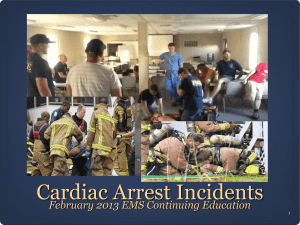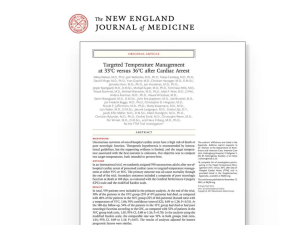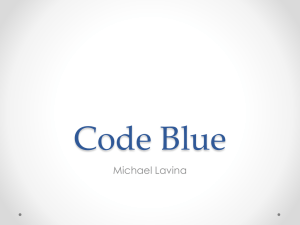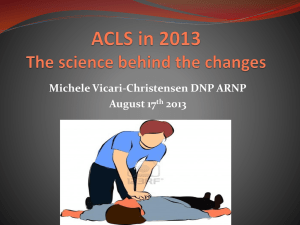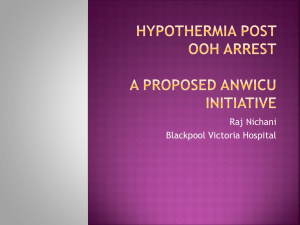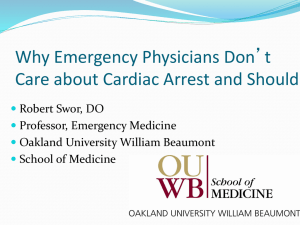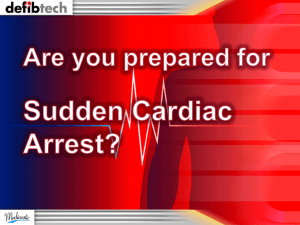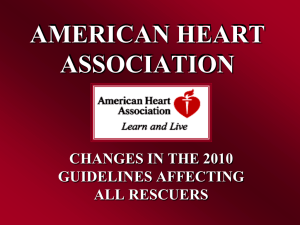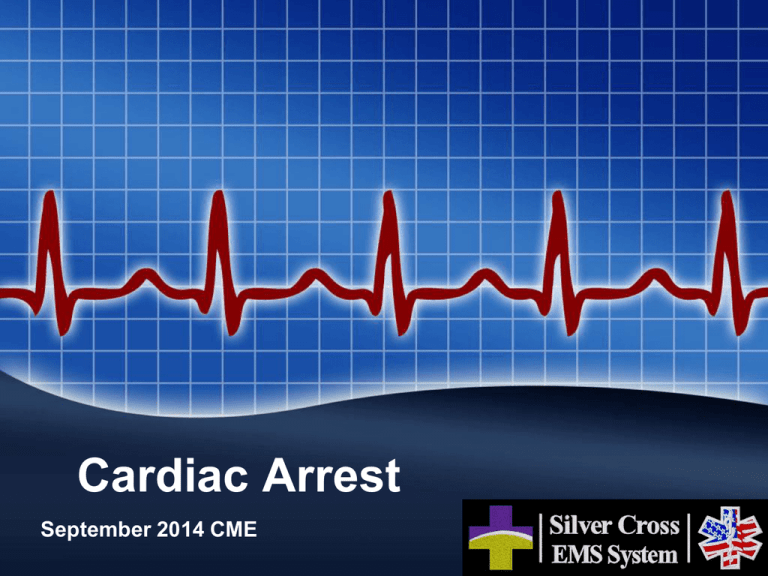
Cardiac Arrest
September 2014 CME
Objectives
• Identify the causes of cardiac arrest
• Identify statistics related to sudden cardiac
death
• Differentiate between sudden cardiac
death and cardiac arrest
• Identify prehospital management for lethal
cardiac arrythmias
• Identify reversible conditions that may
contribute to cardiac arrest
Objectives
• Identify pathophysiological presentations
of cardiac dysrhythmias
• Review SMO’s related to cardiac arrest
• Review of the components of quality CPR
• Discuss “best practices” in cardiac arrest
management
• Review prehospital use of induced
hypothermia for ROSC patients
Cardiac Arrest
• 424,000 people experience out-of-hospital
cardiac arrest (OHCA) every year
• 15-20% annual mortality related to cardiac
arrest
• 8-10% of all EMS-treated OHCA recover
to resume normal lives
Sudden Cardiac Death vs.
Cardiac Arrest
• Sudden Cardiac Death = “Unexpected
death from a cardiovascular cause in a
person with or without preexisting heart
disease” (Circulation; DOI: 10.1161/CIRCULATIONAHA.111.023838)
• Cardiac Arrest = Loss of cardiac function
resultant of:
1) Acute myocardial infarction, OR
2) Ischemia without infarction, OR
3) Structural alterations such as scar formation
or ventricular dilation secondary to prior
infarction or chronic ischemia
What’s the difference…?
• It’s a matter of semantics…
– The SCD studies focus on mortality rates
– Cardiac arrest statistics focus on outcomes;
i.e. survival rates
• Prehospital providers need to look at the
outcomes to determine our level of quality
Risk Factors of Cardiac Arrest
• Coronary Heart Disease
– Fibrous scar tissue formation on cardiac
muscle
• Direct effect on pump mechanism and electrical
conduction pathways
– Ischemia; chronic or acute
• Coronary artery blockages
– Left ventricular dilation, myocardial stretch
• Muscle walls are fatigued
• Precursor to congestive heart failure
Risk Factors of Cardiac Arrest
• Congestive Heart Failure
– Altered calcium regulation
• Decreased calcium = less contractile force
– Fibrous/Scar formation
• Contractile force is inhibited by lack of elasticity of the
cardiac muscle
– Left ventricular dilation, myocardial stretch
• Muscle walls are fatigued
– Hypertrophy (left ventricular)
• Increase in muscle mass, but the muscle does not
increase its pumping ability
• In pathological hypertrophy, the heart can increase its
mass by up to 150%.
Risk Factors of Cardiac Arrest
• Shared Risk Factors
– Age
• From age 50 to 75 there is an 8x greater risk
–
–
–
–
–
–
–
Hypertension
Diabetes
Smoking
Obesity
Renal disease
Inflammation
GENETICS!!!!
Genetics and cardiac arrest
• Cholesterol
–
–
–
–
Represents the strongest link genetically
Elevated LDL (the bad one)
Decreased HDL (the good one)
Increases the risk of cardiac arrest at younger
ages!
• Typically the sub-50 age group; as early as the mid20’s!
– Taken in through food (controllable)
– Produced by the body (uncontrollable)
• Up to 1000mg/day
Athletes and cardiac arrest
• Physical activity can reduce the risk of
cardiac arrest…generally
– Much media attention given to student
athletes with pre-existing cardiac conditions
• Helps raise awareness for early cardiac screenings
Pathology of Cardiac Arrest
• Heart generally progresses through
several cardiac rhythm disburbances…
V-Tach
V-Fib
Asystole
• With pulse
• Without pulse
• Course =
early in onset
• High survival
potential!
• Poor
prognosis for
survival
• Same as PEA
Cardiac Arrest…Let’s Fix It!!
• BLS before ALS!
• Must assess before you treat
• What’s the most important intervention to
be performed in a cardiac arrest??????
CPR
CPR “Chain of Survival”
1. Immediate recognition of cardiac
arrest and activation of EMS
2. Early CPR with emphasis on
chest compression
3. Rapid defibrillation
4. Effective advanced life support
5. Integrated post-cardiac arrest
care
From the “Cardiac Bible”
Circulation: Cardiovascular Quality and Outcomes
(AHA
Publication; http://circoutcomes.ahajournals.org)
• “Summary: Among patients with OHCA, survival
from shockable arrhythmias (VT/fibrillation) has
improved in recent years after the implementation
of guidelines increasing the time devoted to chest
compression during resuscitation. These changes
include reducing the number of back-to-back
rhythm analyses/shocks, eliminating rhythm and
pulse checks after each shock, and increasing the
ratio of chest compressions to ventilations.”
Breaking it down…
“…implementation of guidelines increasing the
time devoted to chest compression during
resuscitation.”
• Minimum 100 compressions per minute
• Maximum 120 compressions per minute
• Compression IS important, BUT, you must
allow FULL RECOIL of the chest to allow the
heart to refill with blood to circulate on the
next compression
Good CPR
Breaking it down…
“…implementation of guidelines increasing the
time devoted to chest compression during
resuscitation.”
• It takes 16 seconds worth of compressions to
obtain enough vascular pressure for oxygen
exchange to occur within the cells of vital
organs
• It only takes 3 seconds of no compressions to
reduce that pressure back to “0”!!!
• Maintain your compressions while you
ventilate
Not So Good CPR
Breaking it down…
“These changes include reducing the number of back-toback rhythm analyses/shocks, eliminating rhythm and
pulse checks after each shock, and increasing the
ratio of chest compressions to ventilations.”
• Get on the chest and STAY ON THE CHEST even
after defibrillation!
• If rhythm converts to a “viable” one after defibrillation
STAY ON THE CHEST for one minute before
assessing a pulse
• When using an AED only stop compressions when the
machine tells you to
• Ventilate once every 5-6 seconds, or once every 20
compressions…NO MORE
Reality Check…
Prehospital personnel are
horrible at CPR
• Why?
– We worry about the “next”
intervention
– We do too much ALS before
BLS
– We spend to much time on
ET/IV/IO insertions
– We think we “already know
this”!!!!
Low Frequency…High Intensity
• Calendar year 2013
– SCEMSS providers care for more than 30,000
patients
– 28 different agencies across almost 300 sq
miles
– Less than 500 documented, non-traumatic,
cardiac arrest patients
– That’s 1.6% of total call volume
How many of you could be
experts at anything you only
practice 1.6% of the time?
Improving CPR outcomes
Best Practices
• The goal is to save lives
• If the rhythm is shockable – Stay and Play
• If the rhythm is not-shockable – Load and
Go
• Only move the patient if…
– Provider safety is at risk
– The rhythm is not shockable
Improving CPR outcomes
Does this mean I may have to stay on scene for 20
minutes doing care? Shouldn’t I be getting this
patient to the hospital?
• So long as the rhythm is “shockable”, patient
survival statistics prove 11% survivability by
continuing aggressive CPR and defibrillation. This
drops to less than 3% in non-shockable
dysrhythmias
• What you do in the field is nearly identical to what
a physician will do in the hospital. So what’s the
hurry when positive patient outcome is the
priority?
Improving CPR outcomes
“Do unto others…”
Knowing what you know now…
This V-Fib patient is your spouse, child,
parent, sibling, best friend, etc…
Are you still going to halt definitive
resuscitation to:
•
•
•
•
•
•
•
•
Move them onto a board
Onto the cot
Pile the equipment up
Move through the hallway
Get down/up the stairs
Out to the ambulance
Into the ambulance
Restage your equipment
And finally resume quality CPR!!
So we have a survivor!
• Induced Therapeutic Hypothermia (ROSC)
– Region VII ALS SMO’s, Code 11
– Key points
• Cardiac arrest not related to trauma, hemorrhage,
or infection
• Age >16
• Not currently pregnant
• Patient is intubated and unresponsive
• Initial temperature > 34 degrees C (93.2 F)
Why ROSC?
• American Heart Association
– 2005 Updates
• Therapeutic hypothermia demonstrates brain
cooling in newborn asphyxia improves nuerological
outcomes
– 2010 Updates
• Therapeutic hypothermia in adult cardiac arrest
patients shows improved neurological outcome for
those that are discharged from the hospital
Why ROSC?
– 2010 Updates, cont’d
ROSC
20 min
Phase
Immediate
Primary Cause of Death
Myocardial dysfunction: 63%
Early
Brain injury: 17%
6-12 hours Intermediate
3 days
Recovery
Multiple organ dysfunction and/or sepsis: 7%
14 days
Hospital Discharge
Survival: 13%
Neurological intact survival: 4%
87% Death Rate
ROSC
• 2010 AHA Outcomes
– Cardiac arrest victims that receive therapeutic
hypothermia show a 13% survival rate to
discharge
– ONLY 4% ARE NEUROLOGICALLY INTACT!
ROSC
• SMO Algorithm
–
–
–
–
–
–
–
–
Return of spontaneous circulation
Initial temp > 34 degrees Celcius
ET in place (NOT A KING AIRWAY DEVICE)
Confirm not responsive to verbal stimuli
Expose patient. Perform 12-lead EKG
Apply ice packs to groin and axilla
Cold saline bolus: 30ml/kg, max 2L
Versed 0.15 mg/kg slow IV push, max 10 mg (for
sedation/shivering) with repeat B/P
ROSC
ROSC
• What current science says…
– “A new study found that contrary to
conventional belief, pre-hospital hypothermia
had no effect on the rate of survival to hospital
discharge or on neurological outcome among
surviving cardiac arrest patients, either among
patients with ventricular fibrillation (VF) or
non-VF arrest.”
• Nuerology Today: Volume 14(2), 16 January 2014, pp 1,9-9
ROSC
• From the same study…
– “However, the results from Dr. Kim’s trial were
not simply that field cooling offered no
advantage to patients. Instead, those patients
randomized to prehospital cooling
experienced re-arrest on the way to the
hospital more often – 26 percent versus 21
percent – as well as increased pulmonary
edema and use of diuretics.”
ROSC
The Decision is Yours…
Choose wisely
Why Discuss Cardiac SMO’s?
Well, because we are not always following
them.
– In November and December 2013, only 32% of eligible chest
pain patients in SCEMSS received nitroglycerin.
» Eligible means appropriate BP, cardiac signs/symptoms, etc….
– In June 2014, only 25% of patients who got Nitro had their
BP or pain level properly reassessed after administration.
– 2014 to date, SCEMSS medics rarely utilized pacing for
symptomatic bradycardia patients.
– During most V-Fib calls in the 3rd and 4th Quarter 2013,
patients never received lidocaine.
SMO’s: The Template of Care
• Template?
– “Templates” are used as the basis of creation.
We act within our “Medical Orders”; to the
degree that it corresponds to how the patient
presents
– NOT “Guidelines”
• Guidelines are “a rule or instruction that shows or
tells how something should be done”
(http://www.merriam-webster.com/dictionary/guideline)
SMO’s
• We already know what to do…we just
need to convince ourselves to do it!
• Be Confident! Be Proud of Your
Knowledge!
– SCEMSS encourages providers to advocate
for your patients
– Use Medical Control to your advantage…NOT
as the “Mother May I…”
– Keep in mind that an “order” from medical
control must be adhered to unless it directly
compromises provider or patient safety!
Medical Control
Your Friend
on the Other
End!
Cardiac SMO Review
• Let’s review ALS cardiac SMO’s. They are listed
on the following slides.
• As you go through them, discuss the notes on
the slides, as well as any other medications or
treatments you have questions about.
• ILS/BLS providers – your trimester test will not
include ALS SMO’s, but it will include questions
on basic cardiac assessment.
Suspected Cardiac SMO
About Aspirin:
•We don’t primarily give aspirin to
cardiac patients for pain relief.
•We give it because aspirin’s bloodthinning properties are linked to better
outcomes for cardiac patients.
•While aspirin can provide a small
amount of pain relief, nitroglycerin and
morphine are the true pain-fighters
during a heart attack.
Aspirin Cautions
• Typical
– Known allergy or Hx GI bleeding
• Atypical
– USE OF BRILINTA
– Do not administer ASA to ANY patient on this
drug!!
– Yes! This is as example of why…“I have a list of
medications coming with” is not acceptable! You
have to ask for current medications!
Brilinta
• BRILINTA is used with aspirin to lower the
chance of having a serious problem with
heart or blood vessels such as heart
attack, stroke, or blood clots
• A dose of aspirin higher than
100 mg daily will affect how well BRILINTA
works
• Doses of ASA higher than 100mg can
cause antagonist reactions; including
blood clot formation
Suspected Cardiac SMO
Some more points to ponder:
•The goal is zero pain. As long as it’s not
contraindicated, nitroglycerin is one of the
best ways to achieve that goal.
•Blood pressure and 1-10 pain levels must
be assessed before AND after each
administration of nitroglycerin.
•IV access is a good idea when giving nitro,
in case BP suddenly bottoms out.
And an FYI:
•Especially in women and diabetics,
weakness, n/v/d, or arm/jaw/back/shoulder
pain may be the only symptom of a cardiac
event. ALWAYS, do a 12-lead.
Nitro…Or…not to Nitro
• For use when…
– Suspected cardiac patient
– Systolic BP > 110 mmHg
• NOT for use when
– Patient is taking nitrates for erectile dysfunction
– Systolic BP <110
– Patient presents with an Inferior Wall MI on 12lead EKG
WHOA!!!
• Inferior wha’? “Of course I know what the
Inferior Wall thing is…It says so on the
printout!”
Bazinga!
$how Me the $TEMI
• Inferior wall STEMI
– ST segment elevation is Leads II, III, and aVF
– Inferior wall STEMI can effect both sides of the heart – effecting
afterload AND preload
– Use of NTG may drastically reduce the patients blood pressure
to the point of syncope
Lead II
Lead aVF
Lead III
Own the EKG
• 12-lead EKG’s know NOTHING about your
patient! Especially, medical history and
current medications.
• 12-lead EKG’s only interpret algorithms
based on patient’s sex and age (if you
have it entered on your monitor)
• 12-lead EKG’s are “**Unconfirmed**”
– They rely on human interpretation of the
information within them
Cardiogenic Shock SMO
Regarding Dopamine:
•We don’t use it a lot, which can make us
afraid to use it when it’s called for.
•But for longer transports, or when waiting for
a far-off mutual aid ambulance to arrive,
Dopamine can save a life.
•You can’t shove fluid into a non-trauma
patient forever without causing it to build up
in lungs and elsewhere.
•Dopamine increases cardiac output and
blood pressure due to its positive inotropic
(related to heart muscle) and chronotropic
(related to heart rate) effects.
V-fib and pulseless
V-tach
•We are doing well as a system with immediately
starting CPR, shocking, and giving Epinephrine.
•Statistics show Lidocaine is not always
administered per SMO requirements.
•If the rhythm changes out of V-Fib/V-Tach too
quickly to draw up lidocaine, that’s fine.
•If patient remains in V-Fib/V-Tach, then it’s time
for an antiarrhythmic… and Lido is what we have.
Tachycardias
•If a patient with tachycardia is unstable (chest
pain, SOB, low BP, altered mental status, shock) it’s time to
cardiovert.
•Don’t delay cardioversion on an unstable
patient while fishing for an IV.
•If you DO have an IV, consider using Versed
for mild sedation
•Be sure to press “sync” before each attempt.
•Some medics feel more comfortable with
medications than cardioversion, but
cardioverting your unstable tachycardic patient
is going to help him/her more than medications.
PEA/Asystole
•Search for the underlying causes
•Hypovolemia
•Hypoxia
•Hypoglycemia
•Hydrogen ions (acidosis)
•Hypothermia
•Hypo-/hyperkalemia
•Tension pneumothorax
•Tamponade
•Thrombosis
•Toxins
•Definitely give CPR and Epinephrine.
But also try a fluid bolus or a warm
blanket. In the case of PEA, sometimes
simple is better.
Bradycardia
•DO YOUR 12-LEAD EKG FIRST!
•SEARCH FOR STEMI AS AN
UNDERLYING CAUSE
•Only give atropine to the non-STEMI patient.
Use of atropine in a STEMI may extend cardiac
muscle damage
• If atropine is indicated but not helping, and
your patient is symptomatic, pace!
•Consider versed, as pacing can be painful.
•Set the heart rate at 70. Start the MA
(milliamps) at zero and increase them until you
feel a pulse and see a paced rhythm.
•Pacing can be alarming if you haven’t done it
before. The patient’s chest may twitch and
bounce. Don’t worry… that’s supposed to
happen.
•If pacing doesn’t work or isn’t available, you will
have to consider dopamine to bring the heart
rate up.
Pulmonary
Edema/CHF
•CPAP and Nitroglycerine are two tools that
are not used as often as they should be.
•CPAP offers quick relief once the patient
becomes comfortable with the mask (which
admittedly can take a minute or two).
•Although it sounds counter-intuitive, Nitro
WILL be more effective with SOB from
pulmonary edema than a nebulizer. That’s
why it comes before Albuterol in the SMO (if
BP is high enough).
•Also, be sure what you are hearing is a
wheeze, not rales/crackles before you
assume it’s COPD and skip the Nitro. In
some cases, patients can even have both!
Cardiac SMO’s Conclusion
• Treating patients according to the SMO’s and thoroughly
documenting that treatment will allow us to continue to provide a
high level of care.
• If we don’t appropriately use the ALS treatments we are given, we
will lose them.
• You won’t get in trouble for deviating from an SMO if you consult
with medical control first, then document your reasons why an
intervention was not performed. We are healthcare professionals,
not EMS robots.
• If the treatment is listed on the SMO, is appropriate for the situation,
and is something you are trained to do, there is no excuse NOT TO
DO IT!
Cardiac Scenario
• As a group determine how you
would respond to this event.
• Use the information provided as a
“template” for your treatment.
• Fill in the blank areas with your
past experiences and you will find
that there is more than one way to
“skin a cat”.
• Have fun and learn from
eachother
Cardiac Scenario Review
You are called to a local high school for the football player
that collapsed on the field at a Friday night game. You
are greeted by a coach and an assistant trainer. As you
observe the scene, you see a group of excited players
surrounding their downed teammate. CPR is being
performed by an off duty firefighter that was watching his
son play, and the team trainer. Patient had just returned
to the bench after a play, became syncopal, and was
assisted to the ground without trauma. Helmet, jersey,
and pads are removed. As you approach the patient, the
attached AED unit blares out, “Do not touch
patient…Analyzing…Shock Advised”.
• What scene considerations are there?
• What can you assume about the patient’s
heart rhythm based on the AED assessment?
•After a shock is delivered from the AED unit, you
continue CPR and apply your cardiac monitor.
You find the rhythm above.
• What is it? What’s the next step?
•You determine your patient needs an initial dose of
Lidocaine in accordance with Region VII, SCEMSS
SMO’s.
•Your patient is 17 years old and weighs 240 lbs.
•What is your initial dose of Lidocaine?
•Will the box above provide an adequate amount of
medication for this patient?
You’ve been on scene working this V-Vib patient
for 12 minutes. Your next monitor check shows
this rhythm.
In accordance with CPR best practices, you
continue chest compressions for one minute,
verify the rhythm is still present, and find your
patient has a carotid pulse.
What do you do?
Scenario Outcome
• You deliver your patient to the ED, still
unresponsive to verbal stimuli but eyelids
flutter on painful stimulation
• Your patients vitals on arrival are
– B/P 106/58
– HR
70
– SpO2 100%
• What do YOU think his outcome will be?
References
•
Deo, R., & Albert, C. (2012). Epidemiology and Genetics of Sudden Cardiac Death.
Circulation, 125, 620-637.
•
Murugiah, K., Chen, S., Dharmarajan, K., Nuti, S., Wayda, B., Shojaee, A., et al. (2014).
Most Important Outcomes Research Papers on Cardiac Arrest and Cardiopulmonary
Resuscitation. Circulation: Cardiovascular Quality and Outcomes, 7, 335-345.
•
Nagao, K. (2012). Therapeutic hypothermia following resuscitation. Current Opinion in
Critical Care, 18, 239-245.
•
Robinson, R. (2014). Why Neurointensivists Are Rethinking the Prehospital Hypothermia
Protocol After Cardiac Arrest. Neurology Today, 14(2), 1,9-9.
•
Stebbins, T., Salomone, J., Gratton, M., & Lindholm, D. (2011). Continous Chest
Compression Protocol Improved Cardiac Arrest Survival Over Historical Cohort. Academy
of Emergency Medicine, 18(5), S147(380).
•
Wampler, D., Schwartz, D., Shumaker, J., Bolleter, S., Beckett, R., & Manifold, C. (2012).
Paramedics successfully perform humeral EZ-IO intraosseos access in adult out-ofhospital cardiac arrest patients. American Journal of Emergency Medicine, 30, 1095-1099.

